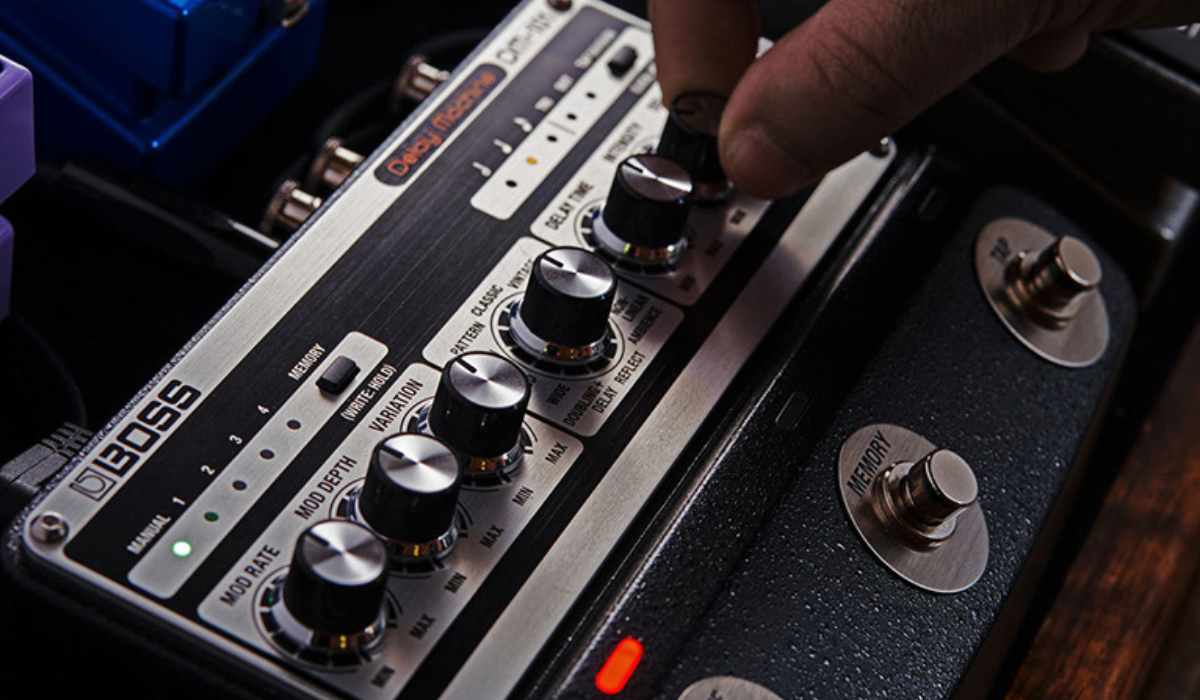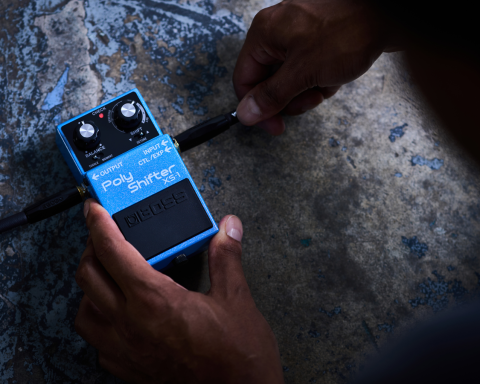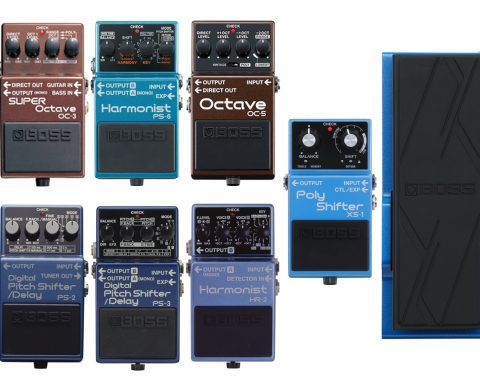There’s so much information out there about delay pedals. This comprehensive delay pedal glossary will help explain each term on a delay pedal. Whether you’ve been playing guitar and using delay pedals for years or are a pedalboard newbie, understanding the terminology can help you get the most out of a delay pedal and use it creatively. Learn the difference between attack, feedback, wow & flutter, and everything in between.
A/D (Analog to Digital)
A/D (Analog to Digital) is the process of converting an analog signal into a digital one for processing within a digital delay pedal.
A/D conversion is used in digital delay pedals and benefits those needing extreme delay times accuracy. A/D (Analog to Digital) is when a guitar’s analog signal is turned into a digital signal for processing and then converted back to an analog signal through a D/A converter for output through an amp. For example, a digital delay pedal uses A/D conversion to manipulate the delay time and repeats digitally and can provide much longer delay times than analog.
Analog delay pedals process your guitar signal directly in its analog form and pump out the sound. They use transistors, capacitors, and resistors to get its effect, creating subtle nuances in delay. Digital delay pedals convert the analog signal of your guitar to a digital format and repeat the delay precisely as before.
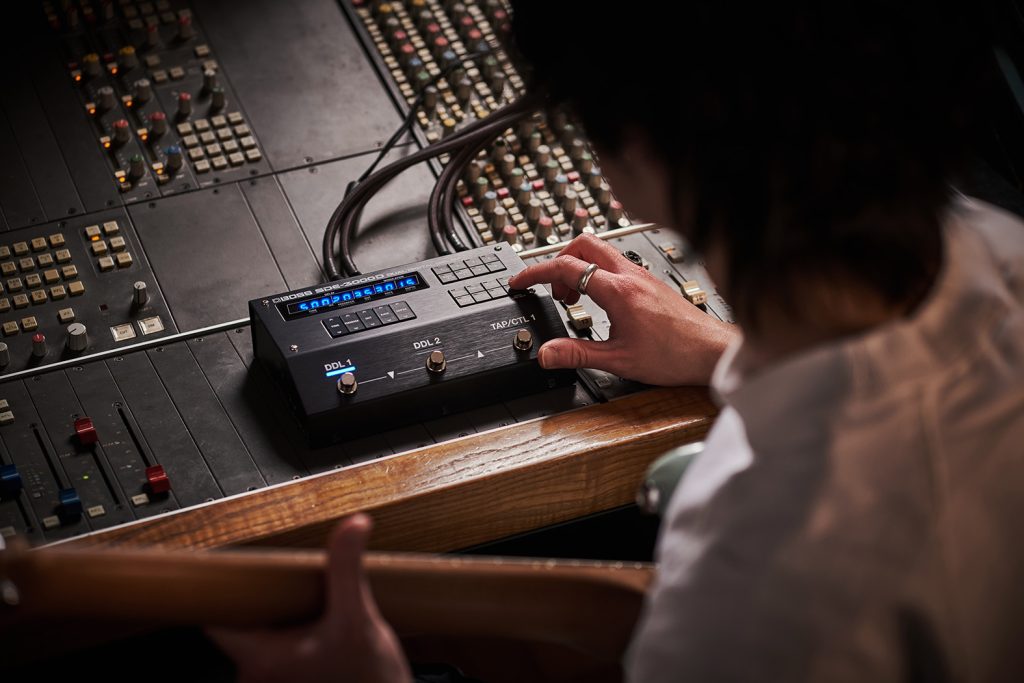
Analog Delay
Analog Delay is a type of delay that uses analog circuitry, typically known as Bucket Brigade Devices, to create warm, vintage-sounding repeats with subtle nuances in each repetition.
Analog delay pedals such as the DM-2W and DM-101 use Bucket Brigade Devices (BBD) to create warm, vintage-style echoes and repeats with a unique nuance each time the sound is repeated. A benefit here is that players can use analog delay pedals to add ambience, unpredictable modulation qualities, depth, and a warmer dimension to solos, lead lines, and riffs.
Attack
Attack is how a guitar’s signal is initially processed by the pedal and then picked up by the amplifier. Less attack is a softer initial repeat; more attack is an instant repeat. Technically it’s the initial part of a sound wave or note played.
In the context of delay pedals, the attack knob can influence how the delay effect interacts with the guitar. A softer attack can create a more ambient, ethereal delay effect that is not immediately noticeable when playing. In contrast, a harder attack means the sound bounces back faster, sometimes louder than the initial note played.
BBD (Bucket Brigade Device)
A BBD or Bucket Brigade Device is an analog delay line circuit where the chips carry a guitar’s signal. As the sound leaves one chip, it goes to another, creating a slightly different sound with each pass-through.
BBDs are used in analog delay pedals to create warm, vintage-style delay effects. They pass the signal along a chain of capacitors, resistors, and transistors. It gets its name from a bucket brigade passing buckets of water. With each passing bucket, some water gets spilled. Similarly, with each delay, some volume gets lost, giving rise to subtle nuances in sound quality. Guitarists love analog delay pedals that use BBD circuits, as each repeat differs slightly from the preceding one.
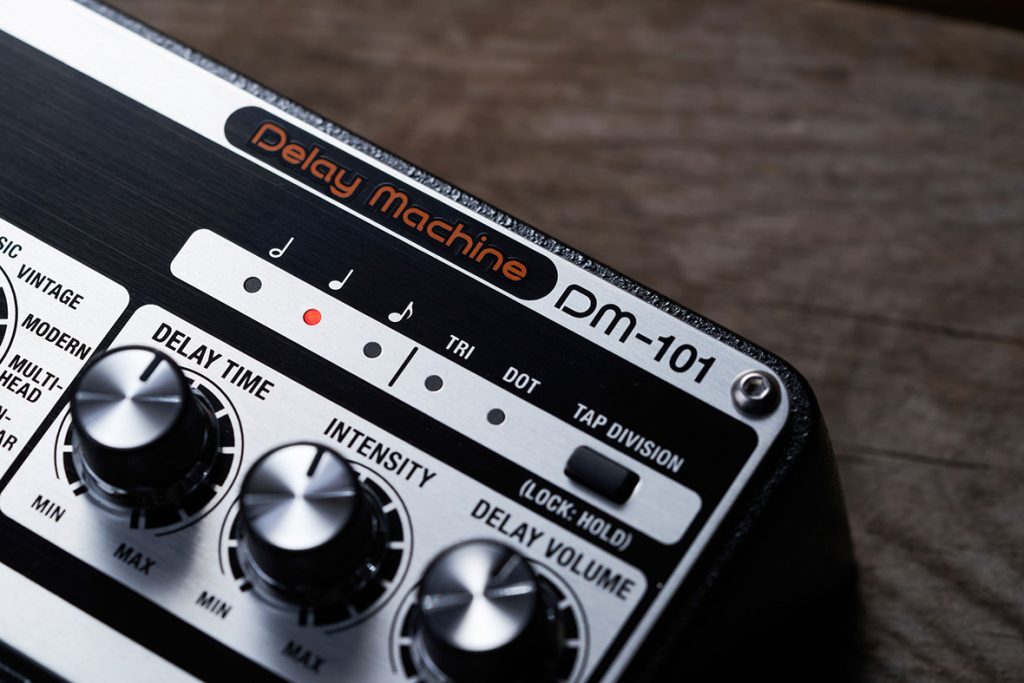
Buffered Bypass
A buffered bypass is a type of bypass that maintains signal integrity in long cable runs.
A buffered pedal strengthens the tone and pushes it through the chain of pedals on the board. This is very useful in preserving signal quality when using a guitar cable longer than 18.5ft and a mixture of patch leads. Fortunately, buffered pedals preserve the integrity of the tone, whether one has the pedal on or off.
Buffered bypass in a delay pedal is especially useful as players need to preserve tone as much as possible so the delay pedal has a strong signal at all times. The bigger the pedalboard and the more cables, the more a buffered pedal helps restore tone.
Delay
Delay is an effect that repeats the input signal after a certain amount of time, creating an echo-like effect. When a note gets played, there is a slight delay, then the sound gets repeated.
Delay is a fundamental tool in a guitarist’s pedalboard and music production. We use delay to create a sense of space and depth, filling in the playing gaps, repeating certain sections, or as an instrument to drive a song.
Digital
Digital refers to using digital processing within the pedal to create the delay effect. The signal gets converted and processed as digital signal.
Digital delay pedals like the DD-200 and DD-3T use digital chip processing to process and then manipulate the delay effect. This provides highly accurate timed repeats, longer delay times, and high-fidelity repeats that don’t degrade with each passing echo.
Digital Delay
A digital delay is a delay type that uses digital processing to create precise, high-fidelity repeats that do not degrade with each repetition.
Digital delay pedals like the BOSS DD-3T and DD-200 offer precise control over delay time and repeats and expanded delay time which doesn’t degrade unless the players desire that effect. They can reproduce the original signal in exact replications, making them ideal for creating crisp, clear delay effects where one needs the same signal at a specific time. They are also ideal for use in MIDI setups, as one can trigger a precisely timed delay that will never falter.
Dotted-Eighth Note
Dotted-eighth note delay is a rhythmic value equal to ¾ of a count. It is often used in delay settings to create a syncopated, “dancing” or “galloping” delay effect. This approach is ideal for filling in the gaps in sound and is the signature sound of The Edge.
Dotted-eighth note delay is probably the most popular setting on delay pedals, often used to create rhythmic, “U2-style” delay effects. For example, one might use a dotted eighth note delay to add a rhythmic element to a part where the delay pedal is a significant feature rather than just in the background, adding ambience. Some digital delay pedals have the dotted 8th delay setting built in, but analog pedals require setting it manually. The DM-101, with its division feature, is an exception.

Patch Work: “Where the Streets Have No Name” by U2
This U2 classic created a new breed of effects-based guitar hero. Learn how to capture its dotted-eighth magic and tone with the BOSS Katana.
Draw
Draw or current draw on an effects pedal is the amount of power a pedal requires, measured in milliamps (mA).
Knowing the draw of a delay pedal is essential for power supply considerations. Most BOSS compact pedals operate using a 9-volt DC PSA adapter with less than 100mA of current draw. Standard power supplies will usually be fine. However, pedals like the DD-200 and DM-101 use a current draw of 225ma and 260mA, respectively. These pedals include an AC adapter to compensate for these higher current draws. It’s vital to check that the power supply can provide the necessary voltage and current so they operate correctly.
Echo
Echo is another term for the delay effect, often used to describe a delay that mimics the natural echo of a large, open space like a cave or well. An echo differs from a delay as the repeats decrease in volume and signal quality faster than a normal delay.
Echo is a classic delay effect, often used to create a sense of space and depth in a mix that sounds more organic than an analog or digital delay. This is why the RE-202 Space Echo sounds so different from the DM-2W and DD delay pedals. It mimics the sound of degrading tape echo delays where the magnetic tape degrades over time. They can add a sense of washy ambience to a guitar sound.
EFFECT LEVEL
The effect level is the control on a delay pedal that determines the volume of the delayed signal and the effect volume. Turn it up to hear the delay more; turn it down, and the delay will be in the background.
The effect level control on a delay pedal allows users to increase or decrease the volume of the delayed signal with the guitar. For example, you might balance the delay level so it’s the same volume as the guitar. Or you might pull it back to sir in the background. You could even increase the effect level, making it louder than the guitar signal for a more pronounced delay effect.
Feedback
Feedback is the control knob on a delay pedal, determining the number of repeats. It can also be known as the Intensity knob on pedals like the DM-2W and DM-101.
The feedback control on a delay pedal allows guitarists to increase or decrease the number of repeats. For example, turning up the feedback will create more repeats, producing a cascading wall of sound.
Gate
Gate is a function on some delay pedals that mutes the delay effect when the input signal falls below a certain level. For example, the delay may only get triggered when a guitarist plays hard and won’t get activated with soft dynamics.
Some delay pedals, like the DD-200, feature a gate function. This feature can create rhythmic, choppy delay effects for slicer-like pattern effects or a ducking effect (where the delay turns on and off sporadically). For instance, one might use a gate on a digital delay to create a stuttering delay effect in a rock song that repeats every third and eighth beats. Or one could set your gate to trigger the delay when the playing volume reaches a certain threshold.
Hold Function
The hold function allows you to sustain the delay effect indefinitely, creating a looping effect. It captures a snippet of the signal and repeats it endlessly.
The hold function on a delay pedal can create a looping effect for a specific riff. For example, on the DD-200, one can hold a particular section and use the pedal to repeat it, creating a rhythmic backdrop. Or players can hold specific notes indefinitely. Below is an example of Hold mode on a BOSS DD-3 digital delay.
Intensity
Intensity is the same as feedback control and determines the number of delay repeats. Pedals such as the DM-101 and DM-2W use the term intensity instead of feedback.
The intensity control on a delay pedal, such as the DM-2W or DM-101, controls the number of repeats from your pedal. Guitarists can set it to singular repetitions or multiples or turn it up all the way so the pedal goes into self-oscillation.
MIDI (Musical Instrument Digital Interface)
MIDI is a protocol for communicating musical information digitally.
MIDI is a protocol that lets pedals and other MIDI devices communicate in the context of a delay pedal. MIDI is often utilized to sync delay times with other equipment like modulation, keyboards, or backing tracks.
A sound engineer or DAW can control MIDI-enabled delay pedals remotely, allowing for precise control over delay parameters when needed. For example, one might use MIDI to switch between preset delay settings during a live performance or trigger exact delay times specific to a backing track.
MODE
Mode on a delay pedal is a setting or knob that allows the user to change the character or style of the delay effect. Examples include reverse, echo, or standard vintage delay.
For example, the DM-101 delay pedal and DD-200 have many different modes. The DM-101 includes 12 analog modes like Vintage, Reflect, and Dual Mod. The DD-200 has 12 digital and analog delay modes, such as Tape, Tera Echo, and Reverse.
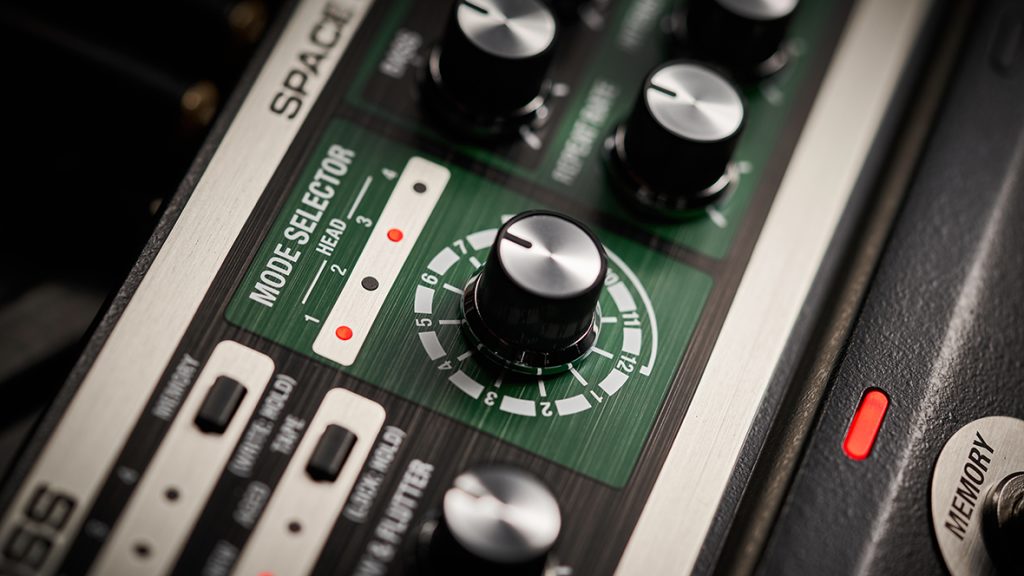
Pattern Delay
With a pattern delay effect, the repeats follow a specific rhythmic pattern, not just a linear on/off style of delay.
Pattern delays can add a rhythmic element to a part playing that does more than repeat a section of the guitar line. Instead, it adds movement and syncopated or unpredictable delays to the sound. For example, one might use a pattern delay to create a complex, rhythmic backdrop for a solo or the DD-200 to create rhythmic sounds with 16 delay lines.
Repeat Rate
Repeat Rate on a delay pedal is another term for the delay time control, which determines the length of time between repeats. Dial it back, and the repeats are almost instant; turn it up, and the repeats take longer.
When one sets the repeat rate control on a delay pedal to a lower setting, it can create long, spaced-out repeats. In contrast, a faster repeat rate can generate a slapback delay effect that country and rockabilly musicians prefer.
Reverse
Reverse delay on a delay pedal is a delay effect where the repeats get played backward.
Reverse delay can create a unique, psychedelic effect. Instead of playing the signal as performed, it takes the sound or lead line, stores it, and then plays it back in reverse, repeating at a player’s chosen rate.
Sample
In the context of a delay pedal, sample is a short snippet of sound recorded or stored by the pedal, played back, and repeated.
Some delay pedals, like the DD-200 and DD-3T, allow users to sample a short sound snippet and play it back as a loop. These units hold a sample and then enable guitarists to play over it.
Saturation
Saturation, in the context of a delay pedal, describes the warm, slightly distorted sound of magnetic tape found on the original Roland Space Echo.
Saturation can add a warm distortion to a delay effect, making it sound like a vintage tape delay machine. The RE-202 also has a separate control to adjust the amount of saturation, which adds this distortion type.
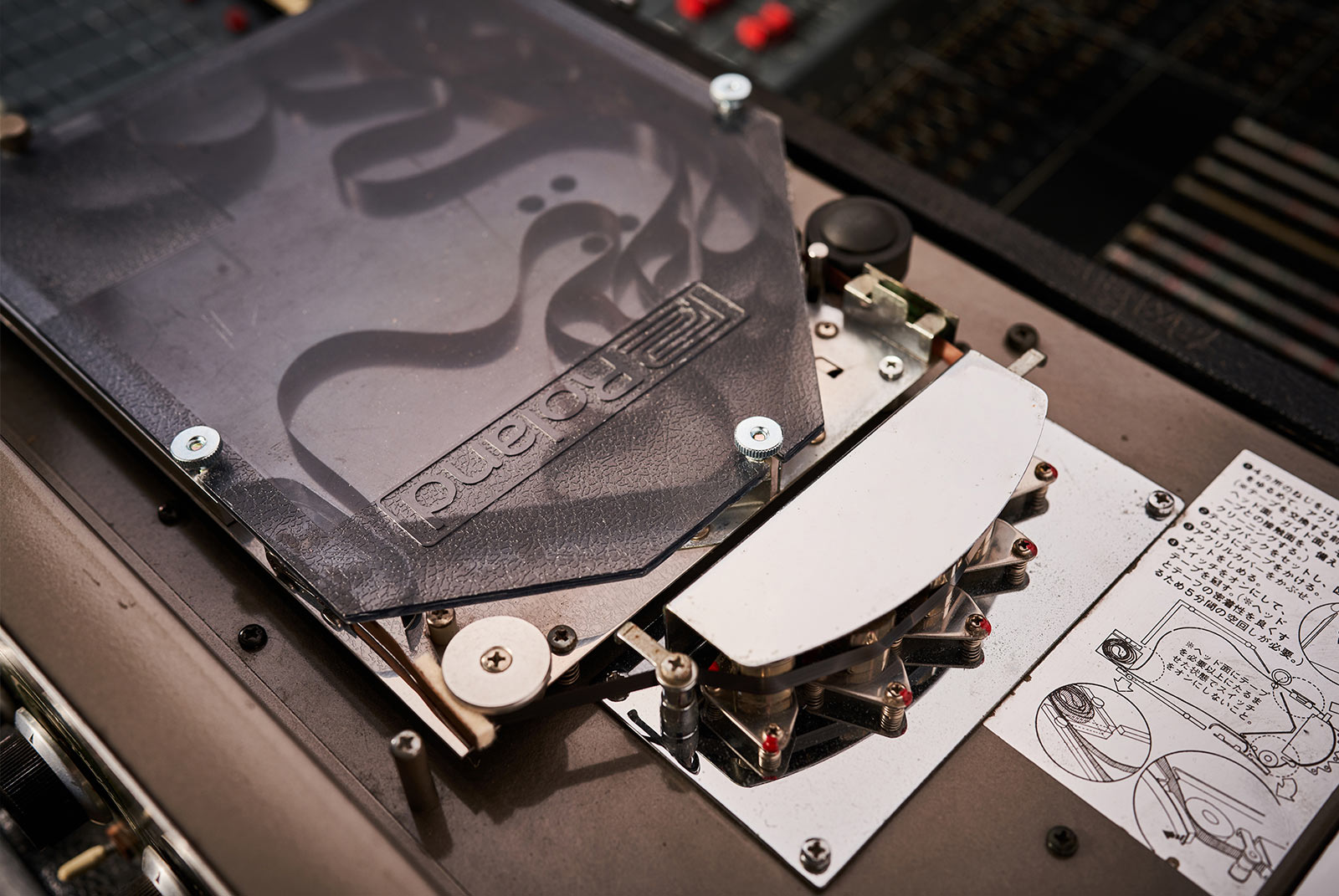
Space Echo Sounds and How to Use Them
The Space Echo series has a storied history. Examine what makes a tape echo unit like the RE-201 sound exactly the way that it does.
Shimmer
Shimmer adds a pitch-shifted copy of the input signal to the repeats, creating a bright, ethereal effect. Shimmer is featured on the DD-200 and is a central feature of the RV-6.
Signal
Signal is the electrical representation of the guitar’s sound that the delay pedal processes. When discussing signal, we are referring to the sound a player feeds into the delay pedal, usually the guitar.
Stereo
Stereo, in the context of delay, means two channels of audio, typically left and right, often used in delay pedals to create a more expansive sound that one can hear through headphones or when connecting stereo outputs to two separate amplifiers.
Using stereo outputs to two separate amplifiers can create a more immersive delay effect by having delay repeats play alternatively through each amp. This approach is like a ping-pong effect across the stage.
Stereo delay pedals like the BOSS DM-101 and DD-200 can create a wide, spacious sound by sending different delay times or patterns to the left and right channels, such as the amplifier or DAW. During playback, one can hear the delay on each side of the headphones.
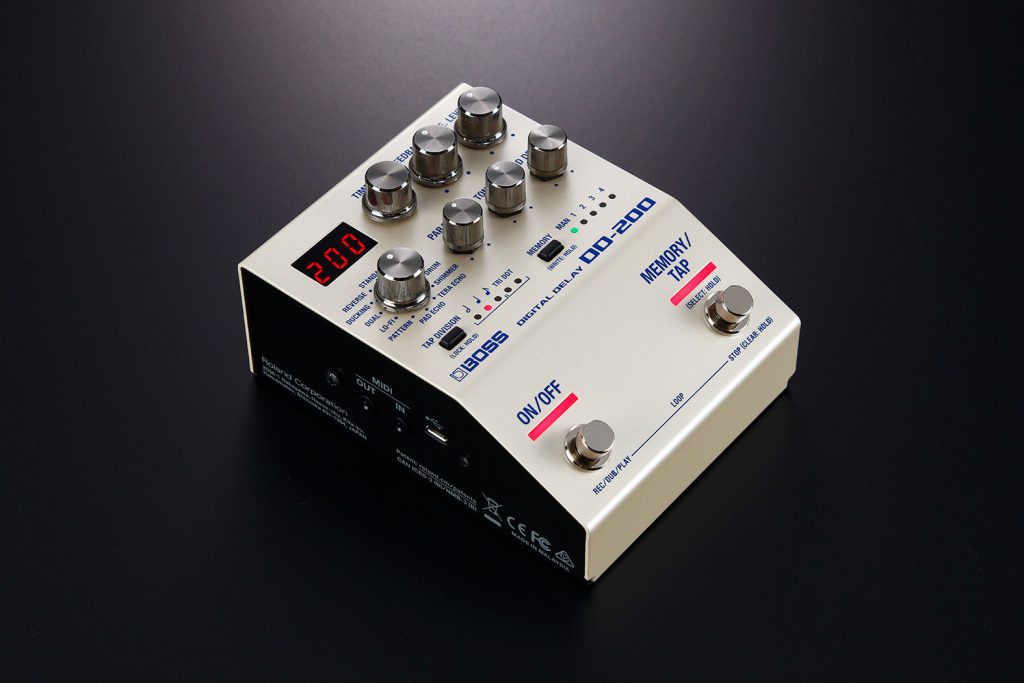
Tap Tempo
A function that allows users to set the delay time by tapping a button or footswitch on the delay pedal in time with the beat.
The benefit of Tap Tempo, as featured on the DD-3T, is that it allows one to sync the delay time with the song’s tempo or create an offbeat tap tempo for a dotted eighth delay. When playing live, one might use the tap tempo function to quickly adjust the delay time to match the song’s tempo.
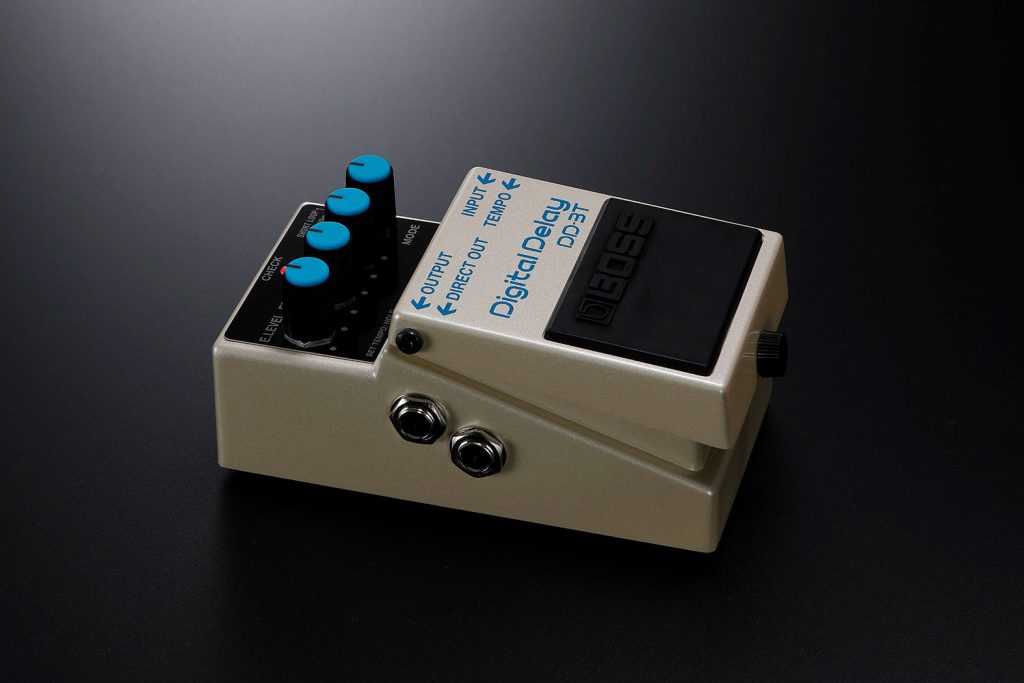
Tape
Tape is a delay effect that emulates or recreates the sound of vintage tape echo machines like the Roland Space Echo.
Tape delay provides a warmer, vintage sound that adds unmistakable degradation and modulation quality. The sound can go from bright and clean with subtle quirks, to dark and murky with a compressed sound and added harmonics caused by squashing waveform peaks. Bands use tape delay machines to get a warmer, more washy, darker echo sound.
Time
Time is the control knob on a delay pedal that lets players set the length of time between repeats. It can also be called Repeat Rate or Rate on a pedal.
True Bypass
True bypass allows the signal to pass through the pedal unaffected when the pedal is off. It adds nothing to the signal and does not restore or boost the quality.
True bypass is a feature on many delay pedals, but BOSS uses buffered bypass at all times to aid in signal clarity and strength. Some pedals can switch between both, which may be helpful if one wants the natural sound degradation from a vintage fuzz pedal.
Twist
Twist is a function that alters the character of the delay effect by pushing the delay sound back onto itself to oscillate. However, the difference between Warp and pitch is that pitch stays the same as the oscillation speeds up on Twist.
If a pedal does not have a Twist function, one can achieve this sound by turning up the Repeats/Feedback. If the pedal starts to oscillate, turn up the Speed or Rate. One can also use an expression pedal, such as the EV-30, to achieve this with the DD-8 and DD-200.
Vintage Delay
Vintage delay emulates the sound of old-school analog delay units such as Bucket Brigade Delays or vintage tape echo machines.
Vintage delay is warm with plenty of quirks and gradual tone degradation. The DM-101 Vintage setting is a retro analog delay sound inspired by the iconic DM-2 Delay pedal introduced in 1981. Players can adjust the modulation behavior by cycling through triangle, sine, and more.

Warp
Warp on a delay pedal increases the level of feedback and ramps up the delay rate.
Warp sounds like speeding up the motor on a mechanical tape echo, which causes the pitch to spiral upwards. This use creates a sci-fi, runaway feedback effect and is featured on the RE-202 and RE-2 delay pedals and the DD-200 delay. Again, the difference here, as opposed to Twist, is that pitch spirals upwards with Warp.
Wow & Flutter
Wow & Flutter describes the pitch modulations found on aging analog tape delay machines where the magnetic tape is starting to degrade.
These small pitch modulations give tape delays character and warmth: that coveted nuanced sound. Wow is a low-frequency modulation related to factors such as a misshapen rubber roller on the tape machine. Flutter is a faster and less regular modulation type due to other mechanical imperfections.
As a rule, Wow & Flutter become more noticeable as a machine ages and uses the magnetic tape. These flaws contribute to the musical sound and inherent quality of tape delay. Tape delays with Wow & Flutter provide rich or warm style delays with unique, unrepeatable characters.

